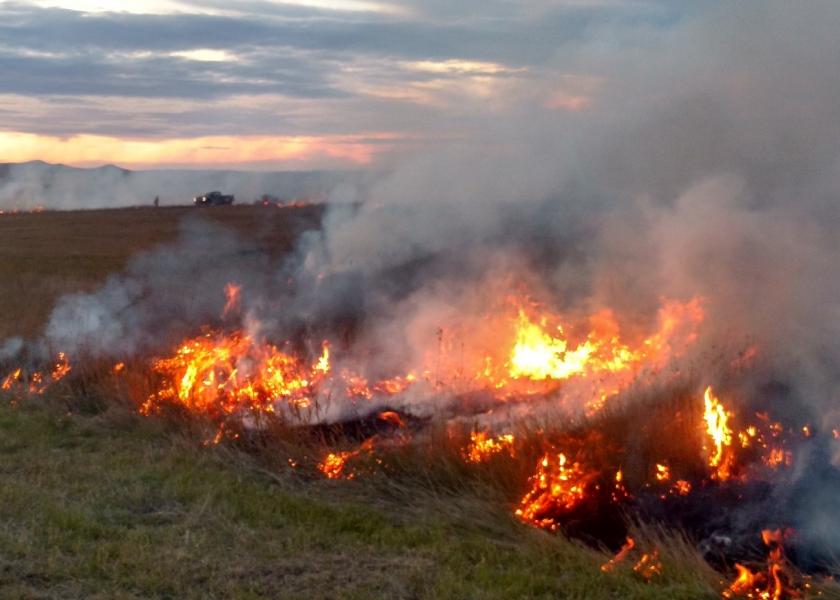Wildfires Can Impact Grasslands

The winter of 2020-2021 has been extremely dry, warm and windy.
As of April 12, all of North Dakota was in drought, with approximately 70% of the state in extreme drought (D3 on a scale of D0 to D4). This condition has created a “perfect storm,” with large amounts of dry vegetation, low humidity, dry soils and wind fueling a high-risk environment for wildfires.
So, what are the impacts of fire on the plant community and forage production, soil erosion and animal health?
“Let’s start with the plant community,” says Kevin Sedivec, North Dakota State University Extension rangeland management specialist and director of NDSU’s Central Grasslands Research Extension Center. “Because the wildfires to date have been classified as dormant-season fires (prior to the growing season), there should be no impact on the plant community in terms of species change on rangelands, plant density on grass hay stands or forage production of new growth.”
NDSU researchers conducted a two-year study on a pasture fire near Lemmon, S.D. This fire occurred in early April 2013. The researchers found no change in plant species composition, but they did see an increase in bare ground and reduction in litter the year of the fire, but no differences the following year.
The U.S. Department of Agriculture’s Agricultural Research Station in Miles City, Mont., assessed the impacts of the fire on forage production. The researchers found the fire actually increased forage production more than 50% during the year of the fire. They also found grazing two months after the fire increased production the highest the following year.
Research at the Central Grasslands Research Extension Center also has shown that April fires have no negative effect on forage production, and grazing one to two months following the burn increased new growth when rotationally grazed.
“Wildfires will remove most of the standing litter, or carryover dead plants, leading to less overall standing forage,” Sedivec says. “However, much of this standing litter is low in quality and palatability.”
The standing litter does protect the soil by acting like armor. Wildfires will increase bare ground, which can lead to a higher risk of erosion. Land with slopes or rough topography will be highly susceptible to erosion or sluffing of soil downslope.
Managing Lands Impacted by a Dormant-season Fire
The most common question will be: “When can I graze my pasture after the fire?”
“This is a tougher question to answer because of many variables,” Sedivec says. “The current drought will impact plant recovery. Past grazing management also will enhance or impede plant recovery.”
If moisture in May and June is normal or above normal, grazing can be conducted at the normal time period, especially on lands with gentle to no slopes. In badland regions or areas with exposed soils and slopes, delay grazing until sufficient growth has occurred to protect the soils. This may be two to four months, but more importantly, the soils need protection with vegetation.
If the drought continues through May and June, delay grazing a minimum of two months to put less stress on the plants while they are growing actively. Most of the grasses will head out, or mature, by early July, so grazing should be safe after that time.
Grazing on badland areas, as seen near Medora or in the Theodore Roosevelt National Park, can increase erosion with an extended drought. These areas will be the slowest to recover and have the greatest risk of erosion.
A continued drought will have the greatest impact on these areas in terms of timing of recovery. Grazing may need to be delayed the longest in these areas to negate the impacts of livestock trailing on these exposed, steep slopes.
Animal Health a Concern
Animal health also can be a concern on burned areas that do not have sufficient recovery of plant growth. Ash and dust can lead to dust pneumonia in livestock, especially the young.
Do not graze freshly burned areas that have little to no new plant growth, especially if the drought persists. Rainfall will settle the dust and ash, leading to new plant growth and a safe environment for livestock.
Sedivec recommends delaying livestock grazing until early May on crested wheatgrass and late May on rangelands, regardless of whether the pasture was burned.
“The drought has created a delay in plant growth and production,” he says. “If you follow this guideline, pastures affected by wildfire should be safe to graze by late May or early June without impacting the plant community or new forage production. The drought will have a greater impact on forage production than dormant-season fires in North Dakota.”







